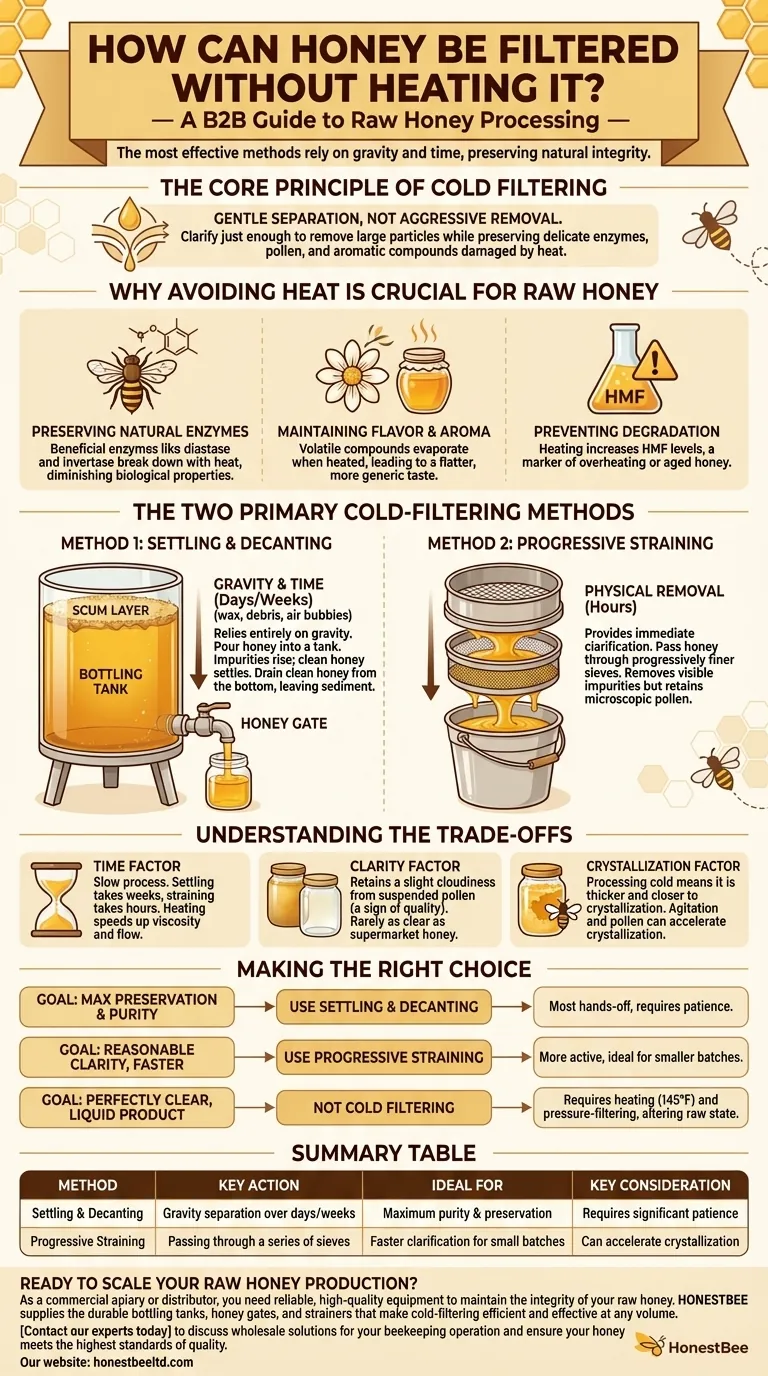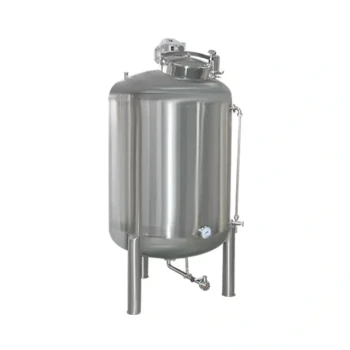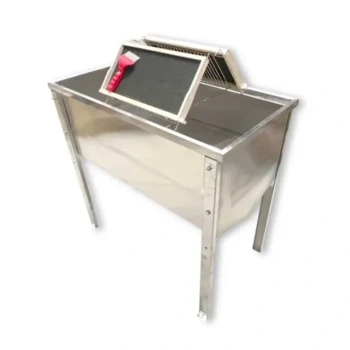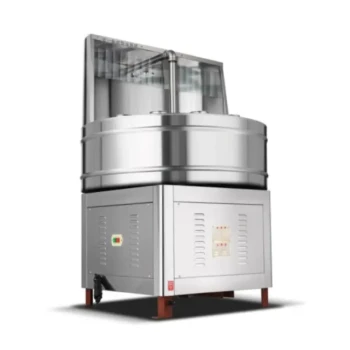To filter honey without heat, the most effective methods rely on gravity and time. The primary technique involves letting the honey sit in a container for several days or weeks, allowing impurities like wax and debris to naturally float to the surface before the clean honey is drained from the bottom.
The core principle of "cold filtering" is not aggressive removal but gentle separation. The goal is to clarify the honey just enough to remove large particles while preserving the delicate enzymes, pollen, and aromatic compounds that are damaged or destroyed by heat.

Why Avoiding Heat is Crucial for Raw Honey
The term "raw honey" implies minimal processing. Heat is the single most significant factor that can alter honey's natural state, which is why avoiding it is a priority for purists and artisanal producers.
Preserving Natural Enzymes
Honey contains beneficial enzymes like diastase and invertase, which are introduced by bees. These enzymes are sensitive to heat and begin to break down when warmed, diminishing the honey's unique biological properties.
Maintaining Flavor and Aroma
The complex flavor profile and delicate aroma of honey come from volatile compounds derived from the original nectar source. Heating causes these compounds to evaporate, resulting in a flatter, more generic taste.
Preventing Degradation
Heating can also increase the levels of HMF (hydroxymethylfurfural), a compound formed from sugar breakdown. While not harmful in small amounts, high HMF levels indicate that honey has been overheated or is old, and it is a key quality marker in the honey industry.
The Two Primary Cold-Filtering Methods
Processing honey at room temperature is slow due to its high viscosity. Both of the following methods require patience but yield a superior, unheated product.
Method 1: Settling and Decanting
This is the most gentle and traditional method, relying entirely on gravity.
It involves pouring your freshly extracted honey into a bottling tank or a food-grade bucket equipped with a spigot (a "honey gate") near the bottom. The honey is then left to sit undisturbed for a period ranging from several days to a few weeks.
During this time, lighter particles—bits of wax, bee parts, and air bubbles—will slowly rise to the top, forming a scum layer. The heavier, clean honey settles below. You can then open the honey gate to drain the pure honey directly into jars, leaving the sediment and surface scum behind.
Method 2: Progressive Straining
This method provides more immediate clarification by physically removing particles.
It works by passing the honey through a series of filters or sieves with progressively finer mesh. This is often done immediately after extraction, such as during a "Crush and Strain" process where the honeycomb is crushed to release the honey.
A typical setup involves a double sieve, with a coarse mesh on top to catch large debris and a finer mesh below to catch smaller particles. Because the honey is not heated, it will flow very slowly. This process removes visible impurities but retains the microscopic pollen grains that are a hallmark of raw honey.
Understanding the Trade-offs
Choosing to filter without heat is a commitment to quality over convenience. It's essential to understand the compromises involved.
The Time Factor
This is the most significant trade-off. Settling can take weeks, and cold straining can take many hours for a single bucket as the thick honey slowly works its way through the mesh. Heating makes honey less viscous, speeding up the entire process exponentially.
The Clarity Factor
Cold-filtered honey will rarely be as crystal clear as honey from a supermarket shelf. It will retain a slight cloudiness from suspended pollen and other microscopic particles. For consumers of raw honey, this is often seen as a sign of quality, not a flaw.
The Crystallization Factor
Processing honey cold means it is thicker and closer to its natural crystallization point. The physical agitation of straining, combined with the presence of fine particles like pollen that can act as "seeds" for crystals, may accelerate the crystallization process once bottled.
Making the Right Choice for Your Goal
Your ideal method depends on your desired outcome for the final product.
- If your primary focus is maximum preservation and purity: Use the settling and decanting method. It is the most hands-off and gentle process, best preserving the honey's natural state, but it requires the most patience.
- If your primary focus is reasonable clarity in a shorter timeframe: Use the progressive straining method. This is a more active process that delivers a clean product much faster than settling, making it ideal for smaller batches.
- If your primary focus is a perfectly clear, liquid product for commercial sale: Cold filtering is not the right approach. Achieving this look typically requires heating to 145°F (63°C) and pressure-filtering, which fundamentally alters the honey from its raw state.
By choosing the right cold-filtering technique, you can produce clean, raw honey that preserves the full integrity and natural benefits of the hive.
Summary Table:
| Method | Key Action | Ideal For | Key Consideration |
|---|---|---|---|
| Settling & Decanting | Gravity separation over days/weeks | Maximum purity & preservation | Requires significant patience |
| Progressive Straining | Passing through a series of sieves | Faster clarification for small batches | Can accelerate crystallization |
Ready to scale your raw honey production?
As a commercial apiary or distributor, you need reliable, high-quality equipment to maintain the integrity of your raw honey. HONESTBEE supplies the durable bottling tanks, honey gates, and strainers that make cold-filtering efficient and effective at any volume.
Contact our experts today to discuss wholesale solutions for your beekeeping operation and ensure your honey meets the highest standards of quality.
Visual Guide

Related Products
- Stainless Steel Honey Storage and Settling Tank with Double Strainer
- Automatic Honey Filling and Filtering Machine for Beekeeping Bottle Filling
- Professional Honey Storage Tank with Agitation System
- Honey Concentrating Vacuum Heating Thickening Machine Dehumidifier for Honey
- Stainless Steel Uncapping Tank with Stand and Strainer
People Also Ask
- How long to leave honey to settle before bottling? Achieve Perfect Clarity in 48 Hours
- What should be done with the condensate in the recovery tank during the concentration process? Ensure Peak System Efficiency
- How long do you leave honey to settle? The 48-Hour Rule for Perfectly Clear Honey
- How long do you leave honey in a settling tank? The 48-Hour Rule for Crystal-Clear Honey
- How long does it take to settle honey? Achieve Perfect Clarity in 2-4 Days



















